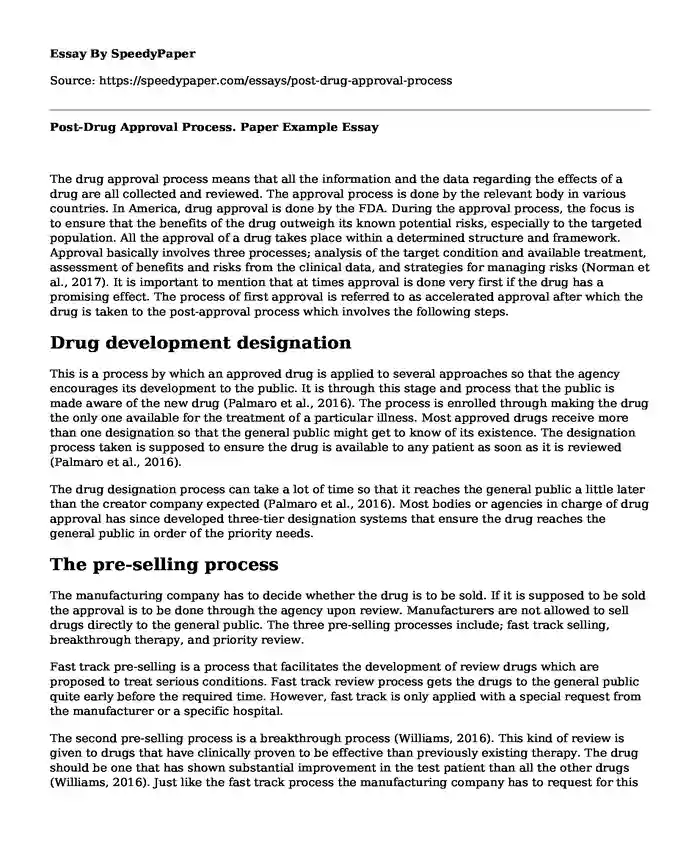
| Type of paper: | Essay |
| Categories: | Medicine Pharmacology Drug Healthcare policy |
| Pages: | 3 |
| Wordcount: | 755 words |
The drug approval process means that all the information and the data regarding the effects of a drug are all collected and reviewed. The approval process is done by the relevant body in various countries. In America, drug approval is done by the FDA. During the approval process, the focus is to ensure that the benefits of the drug outweigh its known potential risks, especially to the targeted population. All the approval of a drug takes place within a determined structure and framework. Approval basically involves three processes; analysis of the target condition and available treatment, assessment of benefits and risks from the clinical data, and strategies for managing risks (Norman et al., 2017). It is important to mention that at times approval is done very first if the drug has a promising effect. The process of first approval is referred to as accelerated approval after which the drug is taken to the post-approval process which involves the following steps.
Drug development designation
This is a process by which an approved drug is applied to several approaches so that the agency encourages its development to the public. It is through this stage and process that the public is made aware of the new drug (Palmaro et al., 2016). The process is enrolled through making the drug the only one available for the treatment of a particular illness. Most approved drugs receive more than one designation so that the general public might get to know of its existence. The designation process taken is supposed to ensure the drug is available to any patient as soon as it is reviewed (Palmaro et al., 2016).
The drug designation process can take a lot of time so that it reaches the general public a little later than the creator company expected (Palmaro et al., 2016). Most bodies or agencies in charge of drug approval has since developed three-tier designation systems that ensure the drug reaches the general public in order of the priority needs.
The pre-selling process
The manufacturing company has to decide whether the drug is to be sold. If it is supposed to be sold the approval is to be done through the agency upon review. Manufacturers are not allowed to sell drugs directly to the general public. The three pre-selling processes include; fast track selling, breakthrough therapy, and priority review.
Fast track pre-selling is a process that facilitates the development of review drugs which are proposed to treat serious conditions. Fast track review process gets the drugs to the general public quite early before the required time. However, fast track is only applied with a special request from the manufacturer or a specific hospital.
The second pre-selling process is a breakthrough process (Williams, 2016). This kind of review is given to drugs that have clinically proven to be effective than previously existing therapy. The drug should be one that has shown substantial improvement in the test patient than all the other drugs (Williams, 2016). Just like the fast track process the manufacturing company has to request for this new breakthrough process.
The last pre-selling stage is priority review (Williams, 2016). This review has to be done within six months of the period when the drug will be made available for the public. In some cases, the review is done between about 10 months which is an under standard review. Under standard review can only be done upon request of the government or any international agencies. After the priority review the drug can now be made available for sale to the public (Williams, 2016).
In conclusion, the process that each new drug or medication goes through can be long and involving before getting to the patient. However, all these are done to the safety and effectiveness of the general public. The process is streamlined to help the public.
References
Norman, J., Madurawe, R. D., Moore, C. M., Khan, M. A., & Khairuzzaman, A. (2017). A new chapter in pharmaceutical manufacturing: 3D-printed drug products. Advanced drug delivery reviews, 108, 39-50, https://reader.elsevier.com/reader/sd/pii/S0169409X16301351?token=0019150d06d6a2d87cb15b936bcad0246ebf3b17e9f614a3faddafa9ef43dcea3e577986b03d15184f0b12a0bd2f6ed8
Palmaro, A., Moulis, G., Despas, F., Dupouy, J., & LapeyreMestre, M. (2016). Overview of drug data within French health insurance databases and implications for pharmacoepidemiological studies. Fundamental & clinical pharmacology, 30(6), 616-624, https://www.ncbi.nlm.nih.gov/pubmed/27351637
Williams, C. T. (2016). Food and Drug Administration drug approval process: a history and overview. Nursing Clinics, 51(1), 1-11, https://www.nursing.theclinics.com/article/S0029-6465(15)00115-2/pdf
Cite this page
Post-Drug Approval Process. Paper Example. (2023, Feb 14). Retrieved from https://speedypaper.com/essays/post-drug-approval-process
Request Removal
If you are the original author of this essay and no longer wish to have it published on the SpeedyPaper website, please click below to request its removal:
- Political Science Essay Example
- Free Essay: My Definition of Success
- Free Essay with Martin Luther King's "Letter from Birmingham Jail" Rhetorical Analysis
- The Hound of Baskerville - Free Essay in English Literature
- Essay sample: Type 2 Diabetes Primary Prevention
- Free Essay: How Would a Supporter of Natural Law View the Use of Torture?
- Essay Sample on Losing Weight with Self-Determination Theory (SDT)
Popular categories




